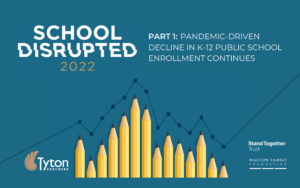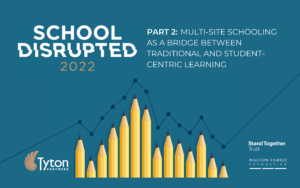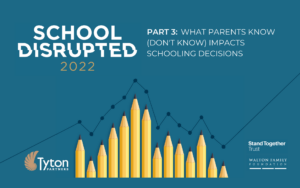Key Learnings from VocTech Market Activity Q3 2025
November 12, 2025 PapersKey Learnings from VocTech Market Activity Q3+ 2025 Tyton Partners and Ufi Ventures Release Q3+ 2025 VocTech Market…
This year, Tyton is publishing School Disrupted 2022 in collaboration with the Walton Family Foundation and Stand Together Trust. In this report, we have extended our work from School Disrupted 2021 to explore how families continue to navigate traditional and alternative school models. Drawing on two surveys of more than 6,000 K-12 parents, School Disrupted 2022 covers key insights and implications in three parts.
 In School Disrupted Part 1, we discuss how the COVID-19 pandemic caused a crisis in K-12 education. Public schools, especially, experienced plunging enrollments, while participation in homeschooling, learning pods and other school models spiked. After the pandemic subsided, many expected K-12 enrollment would return to its pre-pandemic distribution. However, our analysis indicates that the seismic shift in K-12 enrollment persists as more parents choose to homeschool their children or enroll them in a charter or private school. Parents say the primary reasons for this shift are to combat learning loss and safety concerns. Moreover, the flexibility, adaptability, and personalization these alternatives offer are attractive to parents. School Disrupted 2022 examines parents’ shifting preferences and the risks and opportunities they present particularly to K-12 public schools.
In School Disrupted Part 1, we discuss how the COVID-19 pandemic caused a crisis in K-12 education. Public schools, especially, experienced plunging enrollments, while participation in homeschooling, learning pods and other school models spiked. After the pandemic subsided, many expected K-12 enrollment would return to its pre-pandemic distribution. However, our analysis indicates that the seismic shift in K-12 enrollment persists as more parents choose to homeschool their children or enroll them in a charter or private school. Parents say the primary reasons for this shift are to combat learning loss and safety concerns. Moreover, the flexibility, adaptability, and personalization these alternatives offer are attractive to parents. School Disrupted 2022 examines parents’ shifting preferences and the risks and opportunities they present particularly to K-12 public schools.
 Part 1 of School Disrupted 2022 detailed the substantial decline in K-12 public school enrollment since Fall 2020. Our analysis indicates that nearly 10% of public-school students – or approximately four million students – have shifted to charter or private schools, homeschooling, or did not enroll in the K-12 system entirely. We also highlighted parents’ shifting preferences for student-centric learning environments that are, in part, driving this enrollment shift. These preferences have implications for all school models, but present perhaps both the greatest risk and opportunity for K-12 public schools where parents’ desired experiences for their children may be lagging.
Part 1 of School Disrupted 2022 detailed the substantial decline in K-12 public school enrollment since Fall 2020. Our analysis indicates that nearly 10% of public-school students – or approximately four million students – have shifted to charter or private schools, homeschooling, or did not enroll in the K-12 system entirely. We also highlighted parents’ shifting preferences for student-centric learning environments that are, in part, driving this enrollment shift. These preferences have implications for all school models, but present perhaps both the greatest risk and opportunity for K-12 public schools where parents’ desired experiences for their children may be lagging.
 In Part 3, we review how awareness of and interest in alternative school (i.e., those that are not district public schools and are perceived to be more alternative) are related, what concerns parents about these models, and how the K-12 landscape might adapt to parents’ changing preferences.
In Part 3, we review how awareness of and interest in alternative school (i.e., those that are not district public schools and are perceived to be more alternative) are related, what concerns parents about these models, and how the K-12 landscape might adapt to parents’ changing preferences.